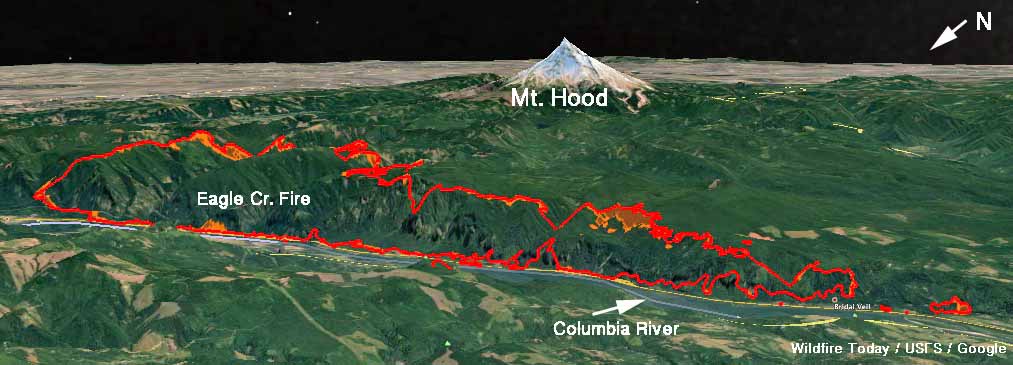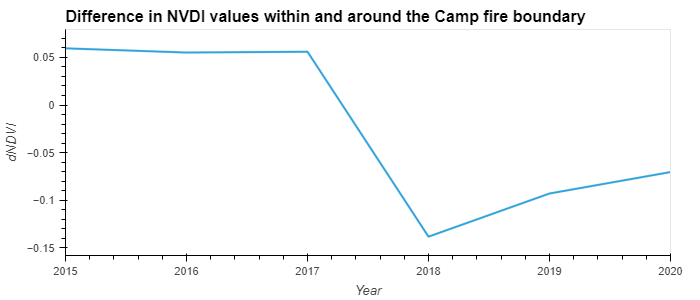The 2017 Eagle Creek Fire near Hood River, Oregon covered more than 48,000 acres and devastated more than half of the Oregon side of the Columbia River Gorge.¶

Image Source: Wildfire Today

Image Source: Oregon Live
On a hot and windy fall afternoon on September 2, 2017, two young teens wrecklessly playing with fireworks ignited one of the largest wildfires in northern Oregon's history, descimating nearly half of the Columbia River Gorge, a famous outdoor recreation area and critical transportation corridor (trains, trucks, and boats).
As the fire quickly grew, 152 hikers were trapped by the flames and eventually rescued while the nearby town of Cascade Locks was evacuated. 2.5 days after ignition, the fire had grown to 10,000 acres and traveled nearly 13 miles in approximately 16 hours, fueled by strong winds. By this time, Interstate 84 has been shutdown and the fire jumped an incredible ~1800 ft across the Columbia River and spread into parts of Washington. Through the blaze, nearly 400 homes were evacuated, hundreds of miles of trail and roadway infracture were destroyed, and historic landmarks, such a Multinomah Falls, closely threatened.
The fire was finally contained at the end of November, nearly two months after it started, but continued to smoulder for another 9-months. A total of 48,000 acres burned in the Eagle Creek Fire. While residents were eventually able to return home, the Eagle Creek Trail system remained closed for three years and remains a visible scar on the landscape today. Massive efforts were put into clearing dangerous trees, installing protective fensing, and monitoring for landslide and debris flows. The teen responsible for the fire was sentenced to 1,920 hours of community service with the Forest Service. If this service is not compled in 10 years, the teen will have to pay $36.6 million in restitution.
2017 Eagle Creek Fire Boundary¶
The API Site for the 2017 Historical Fire Perimeters from the National Interagency Fire Center (NIFC) can be found at:
https://data-nifc.opendata.arcgis.com/datasets/historic-perimeters-2017/api
Location map showing the total burn area of the 2017 Eagle Creek Fire in the Columbia River Gorge near Cascade Locks, Oregon
Assessing Vegetative Health using AQUA-MODIS-NDVI¶
Data Description:¶
Data for this analysis come from NASA's Application for Extracting and Exploring Analysis Ready Samples AppEEARS API portal. The selected layers are 250m 16-day NDVI values (MYD13Q1.061) taken for a three month interval covering peak summer vegetation (June 1 - August 31) for 2015-2020.
The data are a product of the AQUA MODIS satellite and sensor and contain normalized difference vegetation indices (NDVI). NDVI indices are useful for assessing "greenness" or vegetation health in a landscape. These quantitative indices are derived from the measure of light reflection and absorbance across multiple spectral bands which vary with vegetative health.
Citation: Didan, K. (2021). MODIS/Aqua Vegetation Indices 16-Day L3 Global 250m SIN Grid V061. NASA EOSDIS Land Processes Distributed Active Archive Center. Accessed 2023-10-04 from https://doi.org/10.5067/MODIS/MYD13Q1.061. Accessed October 4, 2023.
NDVI data differencing pre- and post-fire¶

Differencing of NDVI data between 2018 and 2016 in the region of the 2017 Eagle Creek Fire indicates a change toward very poor vegetative health within the burn region (boundary defined by black line). The worst impacted areas are near the fire ignition point in the center of the burn region.

Nearly three years after the Eagle Creek fire, most the burned region does not appear to have recovered.¶
During the fire event, NDVI dropped by nearly 0.2 within the fire boundary area compared the region not impacted by the fire. NDVI values pre- and post-fire suggest very slow recovery of vegetation even two years after the fire. Recovery may be accommodated by growth of scrub, but most likely not forest growth. This scrub growth would represent "first growth" which usually includes flowers, bushes, and other small plants near the forest floor. Several more years will be required for the forest cover to recover completely.